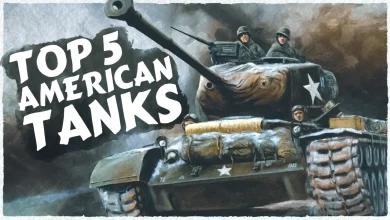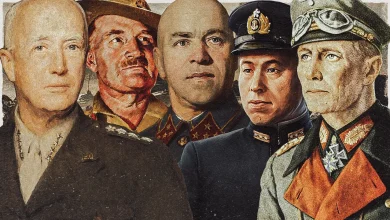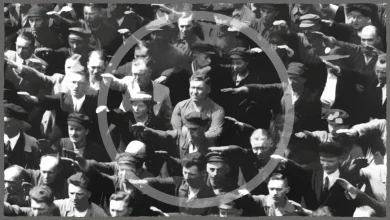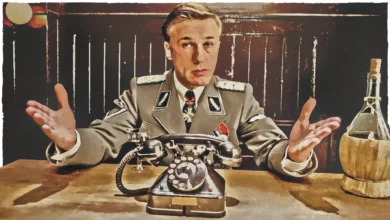Battle of Peleliu – Bitterest Fight for the Marines in World War 2

When US forces approached the tiny island of Peleliu inside the Japanese National Defense Zone in late-1944, the Imperial Japanese high command was determined to defend the small landmass at any cost. By then, the Empire was strictly on the defensive, as their forces had suffered blow after blow while they slowly retreated to their country.
A regiment of 10,000 men belonging to one of Japan’s most experienced and capable regiments, the 14th Infantry Division, was sent to reinforce Peleliu. Their instructions were to hold the islands with their lives, and they were prepared to make the ultimate sacrifice to halt the American incursion.

Meanwhile, American forces composed of the 1st, 5th, and 7th Marine Regiments were ordered to take the island and capture its runway at all costs, as it was one of the most essential airstrips in Asia.
As the Americans landed in Peleliu expecting a weakened Japanese force, they had no idea that the enemy had reorganized and switched tactics entirely, turning into what became known as the bitterest fight for the Marines in World War 2…
A Critical Objective
By late February of 1944, the Allied forces advanced successfully through the Pacific, capturing the Marshall Islands and moving on to the Marianas where 20,000 US troops landed on Saipan on June 15th.
After a fierce battle, where the Japanese offered an outstanding resistance, Saipan was finally under Allied control by July 9th and the neighboring Tinian and Guam Islands were also captured by late august.
Japan was losing ground fast as the Allies penetrated their so-called Absolute National Defense Zone. Consequently, their commanders were becoming more desperate and ruthless week after week and soon began embracing suicide attacks as their inability to hold back the Allies by traditional military means became more evident.

Following their streak of victories, the next objective for Admiral Chester Nimitz’s Pacific Fleet was the Palau Islands and the western Carolines, roughly 500 miles east of the Philippines.
The first island that needed to be captured was Peleliu, a tiny area with only 5 square miles of land. Taking Peleliu was deemed a critical objective for the Allied war effort as it was the location of one of the largest airstrips in the region and could be used by the Japanese to send aerial raids to the islands around it. If the Allies wanted to liberate the Philippines from Japanese control they needed to disable the airstrip first.
Preparations
In 1944, Peleliu was occupied by about 10,000 Japanese soldiers of the 14th Infantry Division led by Colonel Kunio Nakagawa. The island had been systematically reinforced and fortified for several months now, and the Japanese servicemen were well armed with 81mm and 150mm mortars and 20mm anti-aircraft cannons, they were also supported by light tank and anti-aircraft units.
After the devastating defeats in the Solomons, Gilberts, Marshalls, and Mariana Islands, the Imperial Army researched new defense tactics. They then decided to abandon the previous strategy of attempting to stop the Allies on the beaches where they would be vulnerable to naval gunfire. The new strategy entailed disrupting the landings at the water’s edge to then execute primary defensive operations further into the islands.
Colonel Nakagawa used the island’s rugged terrain to his advantage and converted the numerous cave systems within the landmass into an intricate honeycomb system of bunkers and fortified positions, essentially creating a massive fortification out of the natural terrain.
Japanese engineers also installed reinforced steel doors in the natural tunnels connecting the caves and built slanted cave entrances to prevent grenade and flamethrower attacks. Nakagawa also used the high ground to his advantage concentrating his defensive forces on the island’s highest point, Umurbrogol Mountain. This collection of mountains and hills gave the Japanese a clear view of many of the beaches and allowed them to defend the precious airstrip from above.
Meanwhile, the beaches were crammed with thousands of obstacles for the landing craft, mainly mines and several heavy artillery shells that would explode when run over. The battalion was also placed on the beach to delay the inevitable American advance inland where the real defenses were set up.
On the other hand, the U.S. was determined to capture Peleliu, and in September of 1944, they began sending over 17,000 members of the Marine 1st Division to the island. Like the elite Japanese troops garrisoned there, the chosen U.S. forces were among the marine corps’ best-trained troops. The invasion would also be supported by several battleships, heavy cruisers, and light cruisers that would rain fire over enemy defenses before the landing occurred.

The marines were led by Major General William Rupertus who was highly confident in their ability to claim the island swiftly, even going as far as saying that they would not need more than three days to capture it. However, the U.S. forces had no idea that the Japanese had shifted their tactics and they planned to go into the island employing the same strategy that they had used in several amphibious attacks before.
Landing in Peleliu
By the time the first American troops landed on September 15th, U.S. naval support had already bombarded several locations on the island for three days. The preemptive strikes had been focused on the beaches as that was where Japanese forces tended to concentrate their defensive efforts in the past.
As the marines descended from their landing craft they were immediately engaged in a crossfire as the Japanese opened the steel doors guarding their posts and began to fire. The artillery came from both flanks with 47mm guns and 20mm cannons destroying 60 tracked landing and amphibious vehicles in one hour.
As another group of marines descended into what was dubbed Orange Beach. Colonel Chesty Puller barely escaped when a dud high-velocity artillery round struck his landing vehicle. Meanwhile, his communications unit was also destroyed on its way to the beach by a 47mm round.

Covered by coconut groves, the 5th Marines made the most progress on the first day, successfully pushing toward the island’s airfield. Still, they were soon met by a massive counter-attack as Nakagawa’s armored tank company rushed across the airfield to repel the marines. The Americans then returned the fire and the effort was quickly overwhelmed by U.S tanks, howitzers, naval guns, and dive bombers.
As the sun settled in the distance, the Americans held most of the beaches but little else. By then, the Marines had suffered 200 casualties and 900 injuries, but Rupertus was still confident that the Japanese would quickly crumble.
Mounting Obstacles
On the second day, the 5th marines moved to take the airfield and pushed towards the eastern shore. They then approached the airport while sustaining heavy artillery fire from the highlands to the north resulting in several casualties. Still, the Japanese were not the only ones inflicting heavy damage. Temperatures surpassing 115 degrees Fahrenheit were causing many soldiers to perish due to heat exhaustion as they attempted to overwhelm Japanese positions. To make matters worse, the water supply became compromised after it was delivered in contaminated oil drums, increasing the number of casualties.

Despite all the obstacles, the marines were able to capture the airfield but they were relentlessly attacked by the Japanese hiding in the island’s central mountains.
By the third day, and still, under fire, the marines began to use the captured airfield to their advantage, conducting several aerial strikes across the island, dropping napalm and cave entrances, and clearing out the jungle to reveal the Japanese hiding spots.

From then on, the exhausted marines had to storm each defensive post one by one, using smoke grenades to conceal themselves and disable the Japanese weapons while infiltrating the caves.
Fighting in the Caves
The U.S. marines suffered massive casualties as they sluggishly advanced through the ridges and caves on the island. As the losses skyrocketed, Japanese snipers began to shoot at U.S. stretcher-bearers, confident that if they were injured or shot down, more men would have to return to replace them.
The Japanese also broke into the American lines at night to assault the marines in their fighting holes. In response, the U.S. forces built two-man fighting holes so one marine could sleep while the other kept watch.

A particularly vicious encounter then occurred on a ridge known as Bloody Nose for over six days. As the 1st Battalion, 1st Marines under the command of Major Raymond Davis attempted to storm one of the Japanese-occupied hills, they lost over 70 percent of their men.

Captain Everett Pope and his company then infiltrated deep into the ridges, guiding the remaining 90 men to capture the hill. It took them a whole day’s fighting to reach what Pope thought was the top, but it actually was another ridge occupied by more Japanese soldiers.
Realizing that the enemy forces clearly outnumbered them, Captain Pope set up a small defensive post which was then assaulted by the Japanese throughout the night. The marines eventually ran out of ammunition and had to fight the Japanese with knives and fists, even resorting to throwing coral rocks and empty ammunition boxes at them.
Almost miraculously, Pope and his men held out until sunrise which then brought more Japanese onslaughts. By the time they were finally able to evacuate the position, only nine marines were left. Pope would later receive the Medal of Honor for his bravery.
Aftermath
The intricate labyrinth of ridges and caves spread across the island became a lethal trap for the marines trying to make their way to the top of Umurbrogol Mountain, and the operation that was supposed to take three days soon became two weeks, then three and four.
Ultimately, the 1st Marine Division was brutally damaged and stayed out of action until the invasion of Okinawa on April 1st, 1945, suffering over 6500 casualties during its month on Peleliu while the 81st Infantry Division suffered up to 3,300 losses.
On the other hand, the Japanese lost over 14,000 men, close to 10,000 on Peleliu and the rest in the nearby islands. The imperial soldiers fought fiercely to the end, with Nakagawa fighting until all hope of victory was gone and then committing a ceremonial suicide.
Notably, the Japanese were so devout to fighting until the end that a Japanese lieutenant continued hiding on the island and conducting guerrilla warfare until 1947. It would take a retired Japanese commander to convince him that the war was over and that he needed to go home.

The battle became highly controversial in the United States, due to the enormous casualties suffered on top of the island’s lack of strategic value. Further analysis revealed that the Japanese soldiers on the island lacked the means to interfere with potential U.S. operations in the Philippines while the captured airfield did not play any role in the subsequent invasion of the country. Instead, the Ulithi Atoll in the Caroline Islands was used as a staging base for the invasion of Okinawa.
The battle could have become an even greater scandal if it wasn’t because minimal news reports were published about it. This was partly due to Rupertus’ initial prediction of a three-day victory which attracted only six reporters to the scene.
The battle was also eclipsed by the Allies pushed towards Germany and Europe, which can easily explain how one of the most difficult fights the marines encountered during the entire war managed to evade the spotlight for many decades.
Furthermore, as many of the brutal encounters took place deep inside the island’s caves, several U.S. servicemen that lost their lives were never recovered after the battle.
The remains of over 2,600 troops have never been found and recent efforts are underway to reopen some of the blocked caves and find those that gave their lives in the Battle of Peleliu.



